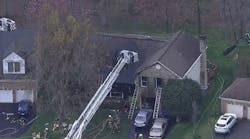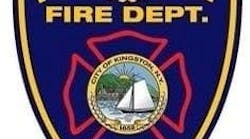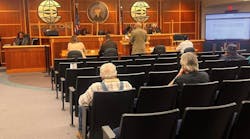The Atlanta Fire-Rescue Department is taking a new and interesting path to approving building permits, plans review and issuing certificates of occupancy. The expressed goal is to be able to issue a final certificate of occupancy in a timely fashion without any surprises to the building owner, contractor or developer.
In a concerted effort to be more "customer friendly" and useful to community and economic development, Atlanta Mayor Shirley Franklin challenged the fire-rescue department to streamline and remove the "mystery" from the initial building inspection and permitting process. As Atlanta is becoming one of America's fastest-growing communities, with about $10 billion of new construction underway and an average of 502 residents moving into the metropolitan area every day, changing our permitting process only makes sense.
The project that served the test bed for our new program is the Georgia Aquarium. This article will take a critical look at the revisions that Atlanta Fire-Rescue is using in the plans-review and permitting process. These changes will raise the bar of customer service and discuss how we are becoming a partner, rather than a perceived barrier, in our community's economic development, while ensuring that Atlanta continues to be one of America's safest cities to live, work and play.
The Test Project
The Georgia Aquarium held its grand opening on Nov. 23, 2005. This was an amazing accomplishment, knowing the scope and degree of difficulty of the project. The design process timeline started months before the site preparation, with Georgia Aquarium CEO Bernie Marcus and his team taking a worldwide aquarium tour. During this brainstorming phase, nearly every public aquarium throughout the globe was visited to gather ideas about "best practices."
I was very pleased to hear in the initial team briefing that safety of the visitors, employees and animals was the driving force behind this elaborate travel and planning phase. In fact, some of the specific lessons learned, which were subsequently incorporated into the building design, included well-marked and identified areas; corridors and exits that are much wider than required; and automated external defibrillators (AEDs) being located throughout the visitors areas.
The building is of Type I fire-resistive construction. I am proud to report that the building is a fully sprinklered facility with all of the required detection and smoke-removal features that are indicated in the International Fire Code (IFC). The fire loading is low to very low, but the emergency response work is expected to be significant. The Atlanta Convention and Visitors Bureau estimates that in the first year of operation alone, between three million and four million guests will visit the attraction. Of course, we are planning for and anticipating a reasonable number of emergency medical responses as a result of this large visitor population.
Incorporated into this building are a public-use food court and a retail outlet center. In other words, the public can enter the non-display area, buy a gift or lunch, and never go into the aquarium tour. It is difficult to predict the visitor numbers that these services will attract, but knowing that Centennial Olympic Park and the CNN Center are only a few blocks away, the best guess is that there will be a significant number of meal-time walk-ups.
The footprint of this complex measures 237,000 square feet. There are two levels in the building, which includes a fish hospital and a world-class aquatic animal research center, operated by the University of Georgia. The plan is to attract the best and brightest "fish doctors" from around the world to study at the Georgia Aquarium. Another major feature of the building is an 1,800-car parking structure. This is connected to the main building and is also fully sprinklered with a wet standpipe system built in for manual fire protection functions.
Atlanta is striving to be a top tourist convention and visitors city. This attraction will go a long way in helping our city to realize this lofty dream. Considering that conferences and conventions generate huge revenues, this attraction will be a great economic boost for our city.
The Permitting Process
As the plans-review process was completed and the massive construction started, an initial certificate-of-occupancy meeting was held. In attendance were our mayor, the aquarium's chief operating officer, the city's building official and me, the Atlanta fire chief. A timeline for a series of temporary occupancy permits (six phases in all) was established to track the arrival of the animals and workers. In order for this project to meet the scheduled opening, which was designed for the health and proper care of the animals, an elaborate planning schedule was prepared. The fire department's goal was to ensure that the building construction was in compliance with the fire code and to project any issues well in advance to alleviate any disruptions of the scheduled critical items.
To reach this goal, weekly meetings were convened that included the fire inspector, building inspector, construction contractor and facilities management under the excellent direction of Atlanta Chief Fire Marshal B.H. Dodson Jr. to discuss the progress of the project. Any emerging issues were discussed well in advance so that adjustments could be made to adhere to the important fish-arrival dates. Using this process and maintaining open lines of communication helped us avoid all of the fire and life safety issues that are associated with this type of complicated project. Instead of the typical disputes that are common for senior management to resolve, this project ran smoothly and on time.
Another benefit of this close working relationship is that all first- and second-alarm companies conducted detailed building familiarization tours in preparation for the grand opening. The building floor plan is complex and required time for our members to learn. Even though this is a secure building site and many controls were implemented, we have been granted a great deal of access during construction. Of course, we could have forced our way into the building, but by having such a positive relationship, that was not necessary and the safety of the public has been paramount. Further, the fire marshal has convinced the aquarium management team that with the large crowds an automated external defibrillator (AED) will be of great benefit to the visitor population. Based on this suggestive input, three AEDs have been purchased and added to the building's safety equipment.
Conclusion
The process model of conducting an on-site pre-construction fire and building code compliance meeting worked very well. The weekly meetings have greatly helped both the contractor and the building ownership to better understand the life-safety issues involved in developing such a major tourist attraction. Potential problems (such as fire exits) were identified early and resolved quickly to keep the project on time.
Based on this experience, Atlanta Fire-Rescue will strive to implement this type of partnership with major construction projects in the future. Although additional upfront resources may be required to complete this process, in the end it is a time saver and keeps the focus on public safety, while eliminating the typical complaints that are usually filed at the end of such a project. It is our hope that additional staffing will be added so that this process can be expanded to all building construction projects.
Chief Concerns is a forum addressing issues of interest to chief fire officers. Opinions expressed are those of the writer. We invite all volunteer and career chief fire officers to share their concerns, experiences and views in this column.
Please submit articles to Chief Concerns, Firehouse Magazine, 3 Huntington Quadrangle, Suite 301N, Melville, NY 11747 or to [email protected], with "Chief Concerns" in the subject line.
Dennis L. Rubin, a Firehouse contributing editor, is chief of the Atlanta Fire Department. Previously, he was city manager and public safety director for the City of Dothan, AL. Rubin is a 33-year fire-rescue veteran, serving in many capacities and with several departments. He holds an associate's degree in fire science from Northern Virginia Community College and a bachelor's degree in fire science from the University of Maryland, and is enrolled in the Oklahoma State University Graduate School Fire Administration Program. Rubin is a 1993 graduate of the National Fire Academy's Executive Fire Officer Program and holds the national Certified Emergency Manager (CEM) certification and the Chief Fire Officer Designation (CFOD) from the International Association of Fire Chiefs (IAFC). He serves on several IAFC committees, including a two-year term as the Health and Safety Committee chair. Rubin can be reached at [email protected].




